Author Archive
Carnival of souls
December 8, 2009* Today on Robot 6 I tipped my hat to Tucker Stone’s decade in review column and Ben Herman’s Beautiful Dreamer sketchbook.
* DC’s next big event is called War of the Supermen. Thoughts:
1) Another “War”! Civil War, Silent War, World War Hulk, War of Kings, The Sinestro Corps War, the “War of Light” meta-story in Green Lantern and Blackest Night, the Invincible War and Viltrumite War in Invincible, and there’s surely more I’m missing.
2) I like J.G. Jones, but, um…
3) This event seems to be patterned after the way Blackest Night, a line-wide event, spun out of Green Lantern‘s Sinestro Corps War, a franchise-based event. The difference, though, is that Sinestro Corps War was hugely popular, whereas I seem to be one of very few people who are following and enjoying the whole New Krypton/World Without a Superman mega-story.
4) The last line here made me laugh pretty hard.
* Frank Santoro presents his haul from the Brooklyn Comics and Graphics Festival.
* Jeez, look at the lighting in this piece by Richard Corben. It’s so realistic I thought I was looking at a photograph of a sculpture, I swear.
* Today’s Strange Tales Spotlight re-run is John Leavitt.
Fire out
December 8, 2009The first few minutes of The Road, director John Hillcoat’s adaptation of Cormac McCarthy’s relentlessly bleak post-apocalyptic novel, tell you pretty much everything you need to know about the rest of the movie. A handful of stand-alone shots metonymize everything the world is about to lose: pretty pink flowers, a soulful-eyed horse. (Viggo Mortensen really has a way with horses on camera.) It’s manipulative and obvious, I suppose, but it works. Then the mysterious disaster occurs, and before we cut to the opening titles we hear the most memorable lines from the book as Mortensen’s nameless protagonist quickly fills his tub with water while his nameless wife looks on: “Why are you taking a bath?” “I’m not.” Man was I ever stunned and devastated by that line when I first read it; launching the movie with it is super-smart. Finally we get to the main business of a man and his son trudging through the ruined world, and as Mortensen’s narration kicks in, it’s almost difficult to believe how careworn and ground down he sounds. Every line is delivered like he’s been on the receiving end of days’ worth of beatings attempting to extract information he’s told us a thousand times he doesn’t have. We see his craggy, scraggly face, his mouth set with a skull’s teeth, and it’s like if Aragorn were wandering around without hope in a world where Sauron got the Ring back. But then you notice the utterly conventional score by Bad Seeds Nick Cave and Warren Ellis, and it’s like ugh, Oscar bait, thanks for playing, goodnight.
Aside from the overscoring and one sequence of bogus suspense involving a then-faceless antagonist that’s shot like something out of a Lifetime movie, there’s nothing bad about The Road. But aside from Mortensen, and a series of holy-shit casting decisions that end up giving us a World Tour of Wonderful Actors from the Great HBO Dramas of the ’00s, there’s nothing about it that feels essential, either. The Tracker-esque ruin and squalor is shifted into that slightly bluish prestige-movie color palette. Charlize Theron’s role is nowhere near as beefed up as rumor had it but nor does it do much but establish that there’s a gorgeous blonde movie star who can also act in the movie (I didn’t buy her fate at all, particularly compared to Mortensen’s reaction to it at the moment and remembrances of it in the future). The moments of horror are kind of expected and bland, except for a couple toward the end that are combined with pathos. And throughout, that score, telling us exactly how to feel at any given moment. I kept imagining the movie without music, like the Coen Brothers’ McCarthy adaptation No Country for Old Men–everything would have improved like (snap) that.
But this film lacked that film’s confidence, both in itself and in its audience. Which I sort of understand. I mean, the subject matter here is even more brutal, which the film does a good job of establishing through intermittent scenes of the Man’s casualness about exposing the Boy to dead bodies. Life has really broken down, and I appreciate the need to give us some outs to dealing with that now and then. In fact I actually applaud the film’s elision of two of the book’s most difficult scenes, involving a dog and a baby; I spent the movie dreading them, simply unsure if I’d be able to take them, and I fortunately didn’t have to. (This also set up a pretty terrific final couple of shots.) Still, on the level of the look and sound of the thing, I was just getting too much reassurance, reassurance that I was watching a motion picture that would address, in ultimately satisfactory fashion, the big questions. The movie seemed to see its job as one of softening the blow. Even though I’m getting to the point (as I realized throughout the screening) where I sort of feel like something’s gotta give with my whole constant rubbing-my-face-in-life’s-ceaseless-awfulness thing, I don’t think that satisfaction was what I was looking for.
Comics Time: Multiforce
December 7, 2009
Multiforce
Mat Brinkman, writer/artist
PictureBox, 2009
22 pages
$15
We tend to think of the breakdown of civilization as a rather stark affair. Things fall apart, the center cannot hold, and before long everything’s a burnt-out husk and people in rags and/or leather underpants are scavenging the wasteland for canned peaches and guzzoline. In keeping with Fort Thunder’s general aesthetic project of information overload, Multiforce imagines the contrary: a replete Ragnarok, a jam-packed apocalypse.
A loosely linked narrative about the warring citizens of a massive mountain redoubt called Citadel City and the even stranger places above and below it, Multiforce‘s serialized strips (they originally appeared in Providence’s visual-noise bible Paper Rodeo) concern themselves primarily with bigness. A giant meets an even bigger giant, who meets an even bigger dragon; little dudes ride around inside the head of a huge dude; skeletal characters dwell in structures and even cities that are shaped like their own skulls, suggesting a preexisting being of almost unimaginable proportions. Half of the book’s narrative juice comes simply from stringing the book’s two protagonists (and the reader) along until the next massive step-up in scale can be revealed. It’s like the comics equivalent of a zoom-out, only suggested through sequential juxtaposition rather than an actual ratcheting back of the viewing plane (that actual technique is seldom if ever used here, to the best of my recollection).
The creatures, which are as gorgeous and inventive and inner-eight-year-old awesome as you’d expect from the product of a man who nowadays makes a living by creating prints of demons and shit, are a constant game of one-upsmanship as well. Brinkman lays this out in an introductory strip, in which we watch a monstrous character who’s super-proud of his awesomely dangerous bionic arm–“I HAVE THE MOST ULTRA ARM IN THE UNIVERSE”–promptly get his clock cleaned by the book’s main, inscrutable antagonist, Battlemax Ace. He’s a battle beast with an axe for one hand and a mace for the other. Yeah, it’s that kinda book. And it’s Battlemax Ace’s unstoppable rampage that brings Citadel City crashing down and provides one of the book’s few genuine narrative and logistical throughlines as he smashes his way through opponent after opponent and level after level. His awesomeness is too powerful to contain.
In many ways these beasties and their navigation of craggy subterranean spaces recalls Brinkman’s landmark collection Teratoid Heights, but that book’s wordless fervor gives way to Brinkman’s loosey-goosey verbal hijinx–his characters bumble around and talk smack like a crudely lettered cross between the Muppets and the stars of a stoner comedy. So the moments of sheer visual poetry stand out in even starker relief–our heroes flying in a sinuous, continuous curve through a Marc Bell riot of a carnival; a dropped head bouncing and rolling down a massive page-tall mountainside; the aforementioned giant skull. But the main takeaway is a set of civilizations so obliviously concerned with their own business and jaded about their potential annihilation that they’re all pretty much fiddling as Citadel City and its environs burn (and explode and implode and collapse and cave in and get smashed by Battlemax Ace and so on). Our heroes even leaven their soaring last-page getaway with a snort of “yea right.” One, two, three, what are they fightin’ for? Don’t ask ’em, they don’t give a damn.
Carnival of souls
December 4, 2009* Now this is a treat, film lovers: The great critic Matt Zoller Seitz elucidates the greatness of the great critics David Bordwell and Kristin Thompson, declaring them The Critics of the ’00s on IFC.com. My feelings about Seitz are no secrets, and like many film students I’ll never forget the way Bordwell & Thompson gave me the vocabulary I needed to articulate things I’d always known but could never say about cinema. I may have forgotten many of those words since then, like I’ve lost my French, but I won’t forget that I knew them.
Digression: In writing about film for this blog I’ve noticed that I don’t talk about form the way I do with comics. Like I said, I’ve lost a lot of that vocabulary, which in turn limits my ability to think that way, and that’s really sad. When I first started regularly reviewing comics–probably for The Comics Journal–it took a shot by Milo George at the state of comics criticism to make me realize that I was doing the usual formula: Three or four paragraphs about the writing, one paragraph about the art, a “to be sure” paragraph, and a conclusion. Figuring out that comics are a visual medium ain’t rocket science, so to confer upon myself a rocket-science degree if you will, I tried to fix this the easiest way I could: I began forcing myself to start reviews by talking about the visual aspects of the comics. Eventually it got to the point where I was comfortable and conversant in that area, so now I feel like I don’t have to make myself do that anymore. I’ll start wherever I feel it makes the most sense to start. When I wrote my review of A Serious Man the other day…well, I’m pretty happy with it, but it occurred to me maybe it’s time to start writing about form first. Of course this is harder with movies you’re seeing in the theater, since you don’t have them in front of you to flip through, and until I’m a paid film critic there’s no way I’m taking notes at a movie theater, man.
* Today at Robot 6: Hot deals from Drawn & Quarterly and hot art from Cameron Stewart and a Hellboy art show by The Autumn Society.

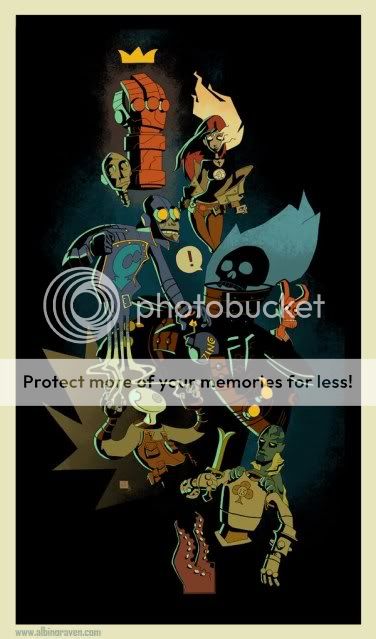
* That Kentucky library that fired a couple of employees for improvised censorship of Alan Moore & Kevin O’Neill’s Black Dossier is moving relevant graphic novels to the adult section. Which is where a lot of them probably belong, so that’s fine. It just really grinds my gears that a couple of bluenoses took it upon themselves to remove books from a library that they worked for. Barbarians at the gates.
* Hurm.
* I’m a little hesitant to draw attention to this eBay auction for a bunch of zines by Josh Simmons and some other people because I want them, but in the words of Godspell, “if that light is under a bushel, brrr, it’s lost something kinda crucial.” (Via Josh Simmons)
* Someone beat World of Warcraft. Seriously, someone did every single thing there is to do in the game right now. Unlike my esteemed colleague Rob Bricken at Topless Robot, who brought me word of this, I actually am impressed by that. That’s a fucking achievement. But the comment thread is less about what the guy did and more about whether or not we should make fun of him, or anyone. As an example of nerd etiquette in the field, it’s fascinating.
Comics Time: Split Lip Vol. 1
December 4, 2009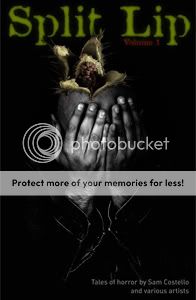
Split Lip Vol. 1
Sam Costello, writer
Josh Bivens, Diego Candia, Gary Crutchley, Nelson Evergreen, Ayhan Hayrula, Brian A. Laframboise, Iain Laurie, Sami Makkonen, Brian McGleenon, Felipe Sobreiro, Kyle Strahm, artists
Tent City, 2009
158 pages
$15
Read it and buy it at SplitLipComic.com
The back cover of this collection of astute horror writer and critic Sam Costello’s anthology webcomic reads in part, “Split Lip sheds traditional horror archetypes in favor of creating dark moods, original characters, and frightening experiences.” Of the three claims I think the first is the best supported. Somber and stark in almost every particular, from plotting to dialogue to his army of collaborators’ art, Costello’s comics quietly but relentlessly reinforce the simple fact that horror is about death. There’s a funereal sadness even in the less effective pieces here, a sense that the horror Costello’s interested in stems not so much from fright as from pessimism. After all, we’re all headed for our own down endings. So to me this offsets the lack of bona fide “frightening experiences”; contra the back cover blurb, I don’t even think that’s what these comics were even going for.
That said, the individual stories vary wildly not so much in quality–I never though “man, this is junk”–as in, like I implied above, effectiveness. Costello’s admirable reliance on the visuals to tell the key parts of his stories, in particular their climaxes or climactic twists, allows the work to rise and fall on how clearly his artists can tell the story, and on a couple of occasions the answer is “not very.” I was left flummoxed by what, exactly, happened at the end of the King-esque cornfield morality play “Straw Men” and the grim fairy tale “Fitcher’s Bird,” while crucial spatial shifts in “Not Sleeping Well,” “The Consequences of a Little Alone Time,” and “School Supplies” were inadequately contextualized. Moreover, stiff figurework on “Straw,” “Consequences,” and “The Executioner Is a Lonely Men” tends toward pulp-ifying fairly restrained writing and, to return to the blurb, mitigating against the originality of the characters. (Given my predilections, I’m tempted to suggest Costello try tapping artists with an out-and-out alternative flavor to them, but I don’t wanna armchair-quarterback this thing.) And on the rare occasion where Costello opts to do the heavy lifting himself, the Ciudad Juarez meets J-horror story “Mujer,” overnarration adds a layer of remove and does in a sense of the story as a living breathing thing.
But elsewhere the writing’s sharp as a knife. Whatever the shortcomings of its visually rushed ending, “Fitcher’s Bird” is kind of uncanny in how well it captures the dark dream logic of classic fairy tales and children’s stories, with their transformations, dismemberments, and ritualistic tasks that must be performed. And the art can shine as well as obscure: Kyle Strahm’s striking white-on-black work in the Western-horror fable “Headin’ South” radiates from the page with the power of agitprop and sets up a nifty negative-image punchline panel to boot. The best of the stories here, “The Tree of Remembrance,” combines strengths on both fronts. For Costello’s part, it’s his least “scary,” most straightforwardly melancholy piece, centered on a striking visual metaphor for the way memories of those we’ve lost can both haunt and heal. Aptly named artist Nelson Evergreen makes the best impression of any of the book’s visual contributors by making the most of Costello’s (according to the book’s supplemental material) uncharacteristically loose script in terms of layout and paneling–the story appears to drift to the ground just like leaves off the titular tree. But Evergreen really kills it with a pair of heartrendingly lovely images of the story’s elderly protagonist in the full bloom of her youth–ha, as I write this I’m listening to the lilting end section to My Bloody Valentine’s “What You Want,” and it’s pretty much the visual equivalent of that. And the pair unite for a starkly gruesome final panel that adds a welcome sour note to the sad sweetness of the proceedings up until that point. It takes a lot for a collaboration of this sort to work so effectively, so when it does it’s a treat, and it’s worth tuning in again to see how often Costello and his collaborators can recapture that moment.
Gossip Girl thoughts
December 3, 2009Not a lot of Gossip Girl thoughts this week, other than these:
* The Thanksgiving dinner was the ultimate Gossip Girl scene in that all the dialogue consisted solely of lies, accusations, and revelations. Plus, I loved watching all the players slowly coalesce. It was like an event comic.
* Vanessa’s mom is awesomely horrible. Bitching Vanessa out for using the woord “doorman,” labeling Thanksgiving a front for the food industry…just magnificent. She’s like what the South Park morons think all liberals are like.
* Chuck Bass, Voice of Morality. How wonderful is his transformation into the Cravated Crusader? I really want to watch him take down a crime boss.
* Rufus needs to learn that when using video chat, the other person can see you wincing.
* Good for Serena’s mom for telling her she’s not welcome there anymore. But I really feel for Serena–being a slut is how she expresses herself! Parents just don’t understand.
* Blair suddenly encouraging Serena to go with Trip? Whaaat? Boo to that. And Serena fails at being a heterosexual woman by choosing Trip over Nate. But don’t worry Nate, Chuck’s there to comfort you…the only way he knows how.
Carnival of souls
December 3, 2009* What’s the most depressing thing about my most likely not being able to make this weekend’s Brooklyn Comics and Graphics Festival? Mat Fucking Brinkman’s gonna be there, that’s what. And thus the Brinkman Bowie is lost to the ages.
* Today on Robot 6: When faced with a Reed/Lucasfilm alliance, Gareb Shamus turns the ship around; and I had a little convo with my pal Jim Gibbons, Dark Horse’s new PR guy.
* I feel like I’ve linked to these before, but really, is there ever a bad time to direct my readers to Aeron Alfrey’s drawings of creatures from Stephen King’s The Mist?
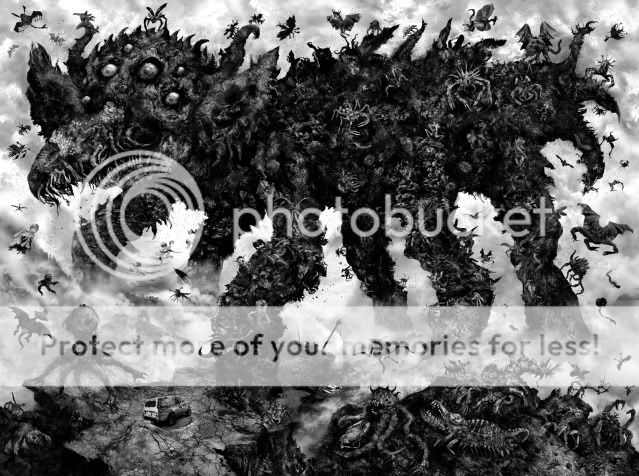
* I greatly enjoyed Rob Humanick’s heavily illustrated Best Films of the Decade list. That’s a gutsy Top 10 right there, man.
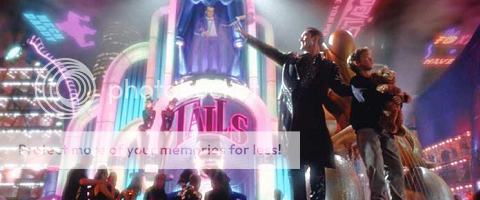
* As the years pass it’s difficult to remember just how noxious Britney Spears first seemed to music fans like me. Well, that’s not quite true–from the very first time I heard and saw the video for “Baby One More Time” I knew there was no arguing with its monstrous greatness. But as the Jesus Christ to the Spice Girls’ John the Baptist she represented the triumph of pop over all the music I really cared about, and it stunk. But today I can read something like Rich Juzwiak’s review of all her singles and B-sides and think “hey, that’s a pretty respectable body of work.” I mean, plenty of junk, but plenty of songs I enjoy hearing too. I never thought I’d comfortably say that but a lot has changed since 1998.
* GOD how I loved MUSCLE figures. Thank you, Topless Robot, for reminding me.

* Here are some truly, deeply horrifying stats on Americans’ support for torture, which is now at levels unheard of even in places like Iran. This is true: When your country has two major political parties and one of them has adopted support for torture as a plank, bad things happen.
* If you spend much time on the industry side of comics, you can probably understand the applicability of the Tiger Woods story–the real story, which is that Tiger’s real story was apparently known to but not covered by the sports journalism world for years. Which in some ways is as it should be, because I don’t think we need to go around panty-sniffing. But on the other hand, when a public figure who is also a major industry presents himself as one thing and the people whose job it is to cover that person know him to be something different…well, you wonder who else knows what else and isn’t telling. (Via Atrios.)
Comics Time: Image United #1
December 2, 2009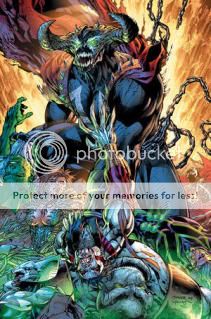
Image United #1
Robert Kirkman, writer
Erik Larsen, Rob Liefeld, Todd McFarlane, Whilce Portacio, Marc Silvestri, Jim Valentino, artists
Image, November 2009
24 pages
$3.99
Wowsers. So, uh, this is a jam comic by six of the seven Image founders, though Jim Lee makes a cameo by providing an alternate cover, which made me smile. It’s about some villains running amok and fighting various heroes for no apparent reason–that’s not my characterization of the plot, that’s the heroes’–which is a pretty fantastic encapsulation of the work of the Image founders to begin with, and certainly their work here. It’s all a moment-to-moment festival of sensation, gritted teeth and punching and blasting and charging the camera, without any kind of prologue or follow-through to place each physical action in any kind of spatial or temporal or emotional context, not even so much as a recap page to catch nostalgic readers up on characters they probably haven’t read since Nirvana was a going concern.
Entrusting layouts to Rob Liefeld (of the six they could have picked from, Liefeld!) could be said to be a mistake, in that characters like the narrator-hero Fortress or the uber-antagonist Omega Spawn burst onto the pages out of nowhere, like they teleported, even though they’re supposed to have been down the block or in the same room, but in light of the above it ends up fitting rather perfectly. At one point the big giant strong hero Badrock [sic] angrily threatens the big giant strong villain Overt-Kill [sic] over an attack we never see on a person who’s not even on panel at the time; later, the long-running Erik Larsen character Savage Dragon, whose appearance in a book filled to the brim with Silvestri and Liefeld creations feels like a walk-on by Glenn Ganges by comparison, remarks “I had no clue the girl took such a hit,” and I had to wonder if this wasn’t Kirkman having some deliberate fun. (I doubt having the arrow-based character Shaft repeat a balloon’s worth of dialogue verbatim two pages apart was deliberate, but wouldn’t it be aweome if it were?)
The most interesting thing about the project is that the artists don’t trade off sections, they draw their own characters whenever they appear, so that you can watch a Jim Valentino hero punch a Todd McFarlane villain, say. The problem with that, though, is that they’re simply not a terribly distinct collection of individual visual stylists. I mean, Larsen’s an exception of course, and Valentino doesn’t look like the rest of the gang but he doesn’t look like much of anything really, and McFarlane might stand out a little in terms of how he choreographs his characters’ physicality but there’s not much of that in this issue, so what you’re left with between Liefeld, Silvestri, Portacio, and McFarlane is a lot of squinty-eyed dudes and dudettes comprised of lots of tiny little lines, standing against generic secret base/rooftop/rubble backgrounds. There’s a manic energy to it, that’s undeniable, but it’s like an album-length guitar solo. It’s all extremely harmless and good-natured–it’s not going to upset you or offend you or leave a bad taste in your mouth, which is saying something–but it’s like being asked for your thoughts on a really rad comic drawn during study hall by the five coolest metalheads in the 9th grade, which not coincidentally is the last time I read comics by most of these guys. It’s all printed on paper stock so shiny it looks like a decade’s worth of gold-embossed chromium glow-in-the-dark holofoil covers were ground up and mixed into the pulp, like KISS’s blood or Mark Gruenwald’s ashes. I think everyone involved, from Kirkman to the Founders to the bulk of the book’s audience, got exactly what they wanted out of it.
Carnival of souls
December 1, 2009* I don’t really have a dog in the Twilight race other than a wife who enjoys it and my own tentative plans to watch New Moon again while under the influence, but I want to take a moment to praise the coverage of the franchise, and of similar projects like Kevin Williamson’s The Vampire Diaries tv show, by Dread Central. They’ve completely eschewed the kneejerk macho borderline-gaybaiting tone taken by the other major horror and geek news sites, and their coverage is all the better for it. (Particularly of TVD, which turns out to be a pretty ripping vampire yarn. Magic rings!)
* Dave Simpson’s profile of the Cocteau Twins’ Elizabeth Fraser for the Guardian is pretty extraordinary in that it simultaneously renews your faith in artists and crushes your hope for artistry. You don’t even need to be a big Cocteau Twins fan to get a lot out of the story of how Fraser’s break-up with her romantic and creative partner Robin Guthrie essentially drove her into artistic seclusion. It’s powerful stuff, and next time you hear “Teardrop” or “Song to the Siren” or “Pearly Dewdrops’ Drops” you’ll be haunted. (Via Matthew Perpetua.)
* The new Comics Journal website launched today, kinda sorta but not really.
* Chris Mautner tackles three recent releases from First Second.
* Bookmarking it for later until I get ahold of the book: Tom Spurgeon reviews Gilbert Hernandez’s The Troublemakers.
* The Maxx on DVD! Good.
* Paranormal Activity on DVD! Bad, because they’re saving the original ending for the Blu-Ray release only, same as they’re saving shitty old Terminator Salvation‘s director’s cut for the Blu-Ray only. I sort of resent being frogmarched into a new format if I wanna be a good nerd. (Via Jason Adams.)
* Go read Joe McCulloch’s post on manga and Manga, the least preachy and not coincidentally most convincing “ignore this stuff at your peril, comics readers” thing you’ll ever read.
* I know sweet fanny adams about the economics of hardcover and softcover collection release patterns from either a publisher or retailer perspective, but I nevertheless sympathize with this statement from Chris Butcher strictly as a person who buys superhero comics pretty much only in trade paperback and wants them to come out more quickly so I can purchase them in a timely fashion:
While I appreciate the short-term $$$ that comes from charging an extra $10 for a hardcover on a book, I think they’re really hurting long-term sales. I know that the whole superhero section of the industry seems to be predicated on short-term thinking, but I think that if it was about giving consumers choice simultaneous releases would be the way to go. This is a bit of a bigger problem than I have time to give it right now, but DC and Marvel mandating hardcover exclusives for 4-6 months means that their biggest, newest, ‘hottest’ storylines remain considerably more inaccessible until well after the heat has entirely dissipated on the series. The Justice Society relaunch is the hardest-hit series I can think of, but Green Lantern and Spider-Man and Runaways from Marvel are also suffering, from my POV, for having long gaps between HC and SC collections.
* Curt Purcell articulates a pretty convincing recipe for compelling event-comic tie-ins. The idea, which he’s expressed before, is that an event comics and its tie-ins are like a bank of tv monitors, and when the main action goes off in one direction, the tie-ins are what continues to play on the monitor the main action just left. The only flaw I see in this is that fans are conditioned to want “what matters,” i.e. what moves the plot forward. Filling in gaps isn’t their cup o’ meat. I suppose the key is to make the filling-in crucial to the sub-story going on in that particular tie-in series.
* Elsewhere, Curt elaborates his thoughts on Blackest Night #5, focusing on the physical portrayal of characters like the Flash and Nekron.
* A Matt Zoller Seitz video essay on Clint Eastwood and vengeance? Sure, I’ll eat it.
* I can’t wait until Habibi drops.
* I haven’t been linking to the previews of Johnny Ryan’s Prison Pit Vol. 2 that the Fantagraphics blog has been posting, but that’s not because they’re not totally awesome, as this supposedly final installment of the preview post series would indicate. Raise your game, New Actioneers!
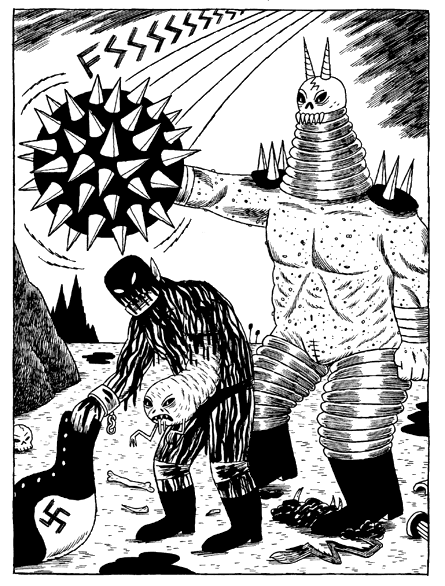
* Alltooflat maven Kennyb’s post on hammerhead sharks made me laugh to beat the band. I won’t spoil the punchline, but it does include this sentence:
what you’re seeing in this picture is a horrifying sea monster with a sixth sense for hearing the physical manifestation of your terror, and smell/taste receptors which are attuned to the scent of your blood in the water.
* Roland Emmerich vs. Lars Von Trier: Fight!
“The terrors of God do set themselves in array against me.”
November 30, 2009Past kindness or consideration. Past justice. Past satisfaction. Past warmth or cold or comfort. Past love. But past surprise? What an endlessly unfolding tedium life would then become. No, Doris, we must not let you be past surprise.
–Francis Wolcott, Deadwood
With all due respect to Mr. Wolcott’s hard-earned wisdom on the topic of a life past surprise, A Serious Man suggests that the flipside of that coin isn’t such great shakes either: A life of constant surprise is indistinguishable from an endlessly unfolding nightmare. As a matter of fact Larry Gopnik, the lead character–whether he’s the titular character is up for debate–has a few actual nightmares, and for varying lengths of time before their resolution you can’t even tell that that’s what they are.
The suburban ’60s Minneapolis the Coen Brothers construct here is an inferno of monstrous self-absorption, obliviousness, and unreasonableness, but rigorously curated so not a whiff of outright parody or condescension can be detected. There’s no out to be found there–these cluttered offices, treeless streets, and hazy screen doors, these nasty neighbors, shrill children, hateful loved ones, and pompous clergymen are crushingly familiar, even if we’re simply seeing their worst excised from the rest of their existence and paraded before us as they buffet Larry to the brink.
Moreover, their world is utterly in thrall to authority, but those authority figures are no recourse. They’re inscrutable, often incommunicado, as likely to blow you off or keel over and die on you as to offer you a glimmer of hope. It’s a world where, as Larry’s dream self points out, he makes a living teaching students that while they can never hope to really know anything, they’ll be responsible for it on tests. It’s a world where a St. Olaf-ian bubbe meise told by a rabbi who can barely be bothered to deliver the punchline is soundtracked by Jimi Hendrix’s single most direct response to the senseless slaughter of Vietnam. So thoroughly lapsed a Catholic am I that I didn’t pick up on the parallels of Larry’s plight with that of Job until deep into the film, but Larry has it worse: Job, at least, could talk to God Himself, but Larry gets saddled with the junior rabbi.
Speaking of rabbis–and we ought to; all three get Tarantino-style title cards, for crying out loud–this is the Coens’ “Jewish movie,” even moreso than Barton Fink. In part this just gives them some rich adolescent nightmare fuel to feed upon, from Hebrew school to bar mitzvahs. (Even a goy like me nearly experienced PTSD during that scene.) But it also enables them to show ethnicity and religion as utterly oppressive. And I mean that in the sense of weight: These characters and images seem to creak and groan beneath the weight of the accumulated centuries of culture–both the internal culture of tradition and the external culture of hatred and stereoytping–that gave them birth, stirring something close to terror at unfathomable roots. This to me is the source of the horror in the film’s opening sequence–not just the visitor’s potentially supernatural origin, but his age, the sense that behind his snowy beard and dry cackle lie the accumulated ages, for good or ill. I know that “self-hatred” is a particularly loaded and even loathsome term with very specific sociopolitical baggage among Jews, so I want to be clear that’s not what I mean–I mean the sense you can get that when it comes to certain individuals of your acquaintance, most particularly yourself and the people you care about, the ancient and fabled foibles of your people are realer than you’d care to admit. I’m Irish, I’ve felt it. Yes, the film’s single most well-meaning and charitably depicted character, the woman with whom Larry shares a seemingly heartfelt heart-to-heart at the beach, seems to have taken genuine comfort in her faith–but the same God who comforts her crippled her.
With that in mind it’s worth pointing out that the film tells two parallel stories itself–those of Larry and his stoner son Danny. At first, clever editing leads us to believe they’re the same story, one a flashback for the other. And though for a long time Danny seems like his father in miniature, unlike him in that he’s unserious to a fault but like him in that life has him in just over his head, his story appears to be headed for a happy ending. He pulls off his transition to manhood while apocalyptically baked (thanks in part to a glance at the sultry Mrs. Samsky, a rare ray of sunshine for Larry as well (and, thanks to a lifelong case of whatever the reverse of shiksappeal is, for me too)), and he receives a life-saving gift and words of true wisdom across a chasm of generations from the head rabbi in charge. But while the closing image of his story is more open-ended than that of Larry’s, it’s still frightening–awesome, in the original sense. Just when he’s about to say what he needs to say to set everything right, something aw(e)ful knocks the words right out of his mouth. And as we’ve learned from Larry, God will never answer out of the whirlwind. Surprise.
Carnival of souls
November 30, 2009* Dan DiDio vs. Joe Quesada on “event fatigue.” This kind of thing is endlessly interesting to me.
* Tom Spurgeon reviews Al Columbia’s Pim and Francie: “this book outright indicts the act of creativity itself.” Shiver.
* Speaking of Spurge, make sure to check out his annual Black Friday Holiday Shopper’s Guide, a tradition I look forward to nearly as much as his San Diego guide. There’s a soul-crushing profusion of good comics to buy.
* Also speaking of Spurge, I appreciated this:
His primary argument as I understood it wasn’t that rankings always work and are always awesome and time well spent, but that he felt the AV Club’s failure to order their list was another choice among many that contributed to their list lacking specificity and weight.
Yep!
* Oh fuck Fantagraphics is a great publisher. More Jaime Hernandez digests! Nancy! Artichoke Tales! Wally Gropius! I could plotz.
* A thousand times yes to this amazing Spanish promo for Lost: Come for the deftly done chess visuals, stay for the deftly selected Radiohead soundtrack.
* A thousand times also yes to Dahmer and The Hurt Locker star Jeremy Renner as Hawkeye, should this pan out.
* A thousand times also also yes to Hellen Jo drawing Lady Gaga and a bunch of other sessy ladies for Giant Robot’s Post-It Show. (Via Heidi Mac.)
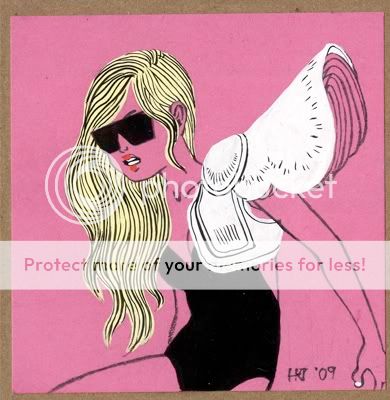
* Paranormal Activity director Oren Peli realizes if it ain’t broke, don’t fix it: His already-finished next film, Area 51, is another found-footage first-person shockumentary thing. The Blair Witch guys probably shoulda stuck with it too.
* Curt Purcell quite liked the latest round of the main Blackest Night books. So did I.
* Real-Life Horror: The Supreme Court sides with the cover-up of detainee-abuse photos.
* Finally, Big Lob, thou art avenged!

Comics Time: High Moon Vol. 1
November 30, 2009
High Moon Vol. 1
David Gallaher, writer
Steve Ellis, artist
DC/Zuda, 2009
192 pages
$14.99
Read the strip at ZudaComics.com
Evolution in action? Here’s a case of the constraints of a comic’s production saddling it with weaknesses, only for the comic to come up with compensatory values that all but overcome them. High Moon is a Western-horror hybrid of the sort very much in vogue over the past few years–what hath Ravenous wrought?–which originally ran in DC Comics’ webcomics portal/competition site Zuda. I believe this necessitated a Sunday-strip-style landscape-format rectangular page, longer than it is tall, as well as a daily-installment delivery mechanism. The storytelling suffers for it all. There’s pretty much one plot beat per panel, with very little breathing room, and moreover nearly every panel contains terse pulp dialogue; the resulting rhythm is staccato to the point of incomprehensibility at times. It doesn’t help that writer David Gallaher’s characters are almost all types, making it even tougher to tell the players at times.
But! Sweet Jesus, look at Steve Ellis’s art. His color palette is a real revelation, fiery oranges and glacial blues all but radiating off the page even despite the book’s rough paper stock. The faces of his hardass outlaws and their lovely ladyfriends come off like a cross between fellow horror artists Terry Moore and Guy Davis, their broad-strokes emotions and intentions easy to parse amid the occasional confusion. I was particularly impressed with his creature designs, admirably ambitious and taking full advantage of Gallaher’s unique, expectation-defying brand of horror-on-the-range. I think I even detected a Robert Williams homage! Ellis’s unnecessarily lovely brushwork really shines in splashpage-style illustrative moments, where you can just sit and stare at the flowing hair and shattered glass and monstrous limbs without feeling propelled to the next rapid-fire panel. It enhances the strengths of Gallaher’s scripting–which include at least one dramatic shift in the story’s direction and an entertaining willingness to throw everything from steampunk to The Crow into the mix–and smooths over some of the weaknesses. Provided you don’t mind when action-horror tilts way way over toward the action end of things, this book is well worth checking out.
Comics Time: Chester 5000 XYV
November 27, 2009
Chester 5000 XYV
Jess Fink, writer/artist
ongoing webcomic, August 2008-November 2009 (and counting)
A steampunk porn webcomic: By god, is this the most Internet-y thing the Internet has ever produced? Regardless, it’s certainly an advertisement for the potential of the web as a publishing mechanism for comics. You can do page after page after page of a cheerful, even sentimental comic drawn in a friendly, loose-fit Craig Thompson-y style (lots of dot-eyes and pointy noses and rapturous swirls) about a woman getting fucked by a robot with a mustache, and Diamond minimums be damned. I stumbled across this by following a link trail from Kate Beaton’s place, which seems somehow appropriate–good luck getting your gag-comic series about historical figures off the ground without a David Finch variant cover, too.
To set the scene: It’s the story of a workaholic Victorian-era scientist who, unable to satisfy his lovely wife’s needs when he’s knee-deep in lab work, builds her, essentially, the world’s most sophisticated vibrator: A humanoid robot who can go-go-go-go and keep the missus busy when the Scientist’s working. Unfortunately for him but fortunately (?) for them, the lady and the robot (the titular Chester) fall in love, as best I can tell because the sex is really awesome and because of Chester’s “programming”–the scientist placed a picture of his wife where the robot’s heart would go. Eventually the Scientist attempts to sell Chester off to a local widow, but Chester has ideas of his own, and this other lovely young lady gets embroiled in the shenanigans, where we’re currently left as of the strip’s latest installment.
My relationship with this comic as I read its year-plus run in one go fluctuated fairly wildly, which surprised me. Now, steampunk’s not really my thing, and the very twee line and look Fink employs generally needs to be shored up by some genuinely meaty content to pass muster with me. Of course, this being a porno comic, there’s a pretty simple way to figure out if it’s working, and work it does. It’s graphic, so there’s that, and there’s a repeated emphasis on clitoral stimulation that all but single-handedly (rimshot!) makes up for the American education system’s sex-ed dropped ball on that score, which has left generations of young men unable to find the thing with a map and a flashlight. (Please change your standards in this regard, Department of Education–the high school girls of America will thank you!) But in addition to all the sensually drawn close-ups of genitalia, Fink has a knack for capturing not just the act, but the desire to act, if you follow me–a look in the lady’s eye as she gets ready to get it on with Chester, the heat-of-the-moment kissing and grabbing and gasping and so on. The build-up to the sequence involving the two women is particularly strong in this regard, though of course I’m a dude with a typical dude’s sensitivities in that area, so, you know, unreliable narrator.
But amid all the cute romance and hot sex and meme-able robot stuff, like I said, there’s some surprisingly tricky terrain. Is the scientist’s obsession with his work really a valid excuse for his wife to so enthusiastically and totally cuckold him–with a gift he gave her, no less? I was pretty sympathetic to the Scientist’s outrage over this–until he took it way too far and flipped my sympathies yet again. When the Widow enters the picture, as much as I enjoyed watching her dive in, I found the notion that, basically, everyone is sexually compatible with everyone…snobbish, in a way? Does that even make sense? But as the four characters are currently coupled off, I feel like we’re seeing adults make a decision about how they really want to live their lives, even though they’re making it with their sex organs at the moment rather then their brains. I don’t know…it’s heady stuff, in its way, and demanding of one’s attention and non-lizard-brain thinking, keeping you actively engaged rather than passively taking in the pretty curved lines and button-pushing romance and dirty drawings. Very interesting.
Comics Time: Just a Man #1, Lost Kisses #9-10, Worms #4, and XO #5
November 25, 2009
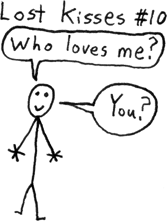 Just a Man #1, Lost Kisses #9-10, Worms #4, and XO #5
Just a Man #1, Lost Kisses #9-10, Worms #4, and XO #5
Brian John Mitchell, writer
Just a Man #1 – Andrew White, artist / 56 pages
Lost Kisses #9 & 10 – Brian John Mitchell, artist / 36 pages each
Worms #4 – Kimberlee Traub, artist / 40 pages
XO #5 – Melissa Spence Gardner, artist / 44 pages
Silber Media, 2009 (I think)
$1 each
Wow, these little suckers put the “mini” in “minicomic.” They’re just under an inch and a half square, limiting the comics they contain to one image-caption pairing per page. It’s an interesting constraint to work impose upon oneself, given that auteur Brian John Mitchell is already up against his own inability to draw. That’s not a subjective assessment, by the way–we’re not talking Jeffrey Brown lo-fi or Brian Chippendale noise or John Porcellino minimalism or Anders Nilsen stick figures or anything else that’s a matter of taste in the Mitchell-drawn Lost Kisses, we’re talking actual stick figures, with little happy-face faces and five even tinier sticks for fingers. Mitchell’s enthusiasm for making comics outstripped his ability to master even its most basic necessities. Which is kinda cute, I’ll admit, and works well enough for the kind of ramshackle navel-gazing confessional humor he’s doing in that particular series, but the air of self-indulgence is unmistakable. Making matters worse is a problem with image flow–I know, hard to believe given that you’re just dealing with one tiny picture and caption on every page. But Mitchell places the drawings on top of the captions even though the drawings respond to what’s said in the captions, so that you either have to read bottom-to-top or constantly spoil the gag for yourself. I have no idea why he does that way–surely he noticed it doesn’t scan? I don’t think it’s a formal innovation done for effect, like Chippendale’s chutes-and-ladders layouts–I just think it’s a mistake.
Which is what makes the other three comics in the envelope Mitchell sent me all the more surprising. Not due to the presence of other artists, mind you–White’s work on Just a Man is scratchily effective, particularly with some effects involving sun glare and flames, but Traub aims for abstraction and ends up coming out just sorta sloppy, while Gardner’s basic cartoony figures look like they came from any number of entry-level webcomics or student-newspaper strips. No, what’s impressive here is how the physical constraints of Mitchell’s tiny format are made to enhance his storytelling. When you have so little room that simply printing a sentence at a legible size eats up half your page, you’ve gotta keep things terse, so why not go hard-boiled and tale tales of murder and mayhem committed by flat-affect protagonists? Just a Man is a Western morality play of violent retribution; a couple of moments overstate the case, I think, but in general it’s a chilling thing, with some memorable facial expressions from White and a surprisingly, refreshingly open and un-cliche ending. XO is a series, but this is apparently the origin story for its blase hitman protagonist, and believe me you didn’t need to know this to appreciate the bracing matter-of-factness with which the character unwittingly but unhesitatingly graduates from selling drugs to eliminating an exceedingly minor threat to that undertaking. Worms is the least effective of the trio–the art just doesn’t do what it wants to do–but the story seems like an engaging enough Cold Heat-style weird-tale sci-fi mindfuck involving a young woman in peril and fighting to break free, and it sure does take a turn for the suddenly brutal at one point. In more assured hands, all three could be really killer melds of form and function. As it stands, they’re maybe not quite there, but if you wanted to spend a measly buck per book, even just to examine what they do right and what they do wrong, you’d have my blessing.
Happy Thanksgiving from your friends at Marvel Super Heroes: What The–?!
November 25, 2009I only wish the title “99 Hulk Balloons” had been my idea.
Hey, look, Christopher Allen interviewed me about comics criticism
November 25, 2009Right here. Chris really pressed me on a lot of my assertions and assumptions, so I had a great time with the interview. I hope you will too!
Carnival of souls
November 24, 2009* I’m pretty happy with the way my Robot 6 piece on what’s wrong with the AV Club’s Best Comics of the ’00s list came out. Please give it a look.
* Elsewhere on Robot 6 I shouted, shouted, shouted out loud Tom Neely’s post-it portraits of metal musicians in corpse paint.

* Curt Purcell dashes himself against the rocks of event-comic tie-ins.
* It’s C.F.’s world, says Blaise Larmee, and we just live in it.
* RIP Ken Krueger, co-founder of the San Diego Comic-Con. These men gave us something wonderful.
Carnival of souls
November 24, 2009* Today on Robot 6: I plugged AdHouse’s big sale, recapped Tom Brevoort’s Marvel vs. DC smacktalk, and recounted The Twilight Saga: New Moon‘s box-office battle with Batman and Spider-Man.
* Eve Tushnet:
This isn’t art you experience, or even art you endure; it’s art you solve.
Boo, hiss!
* Dig this Lane Milburn/Jon Vermilyea Cold Heat print!
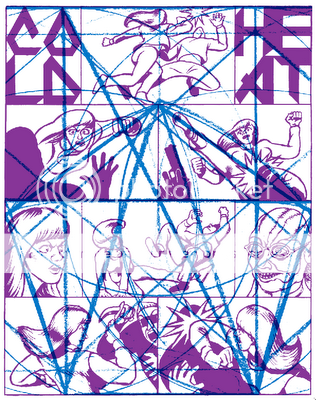
* Dig Nick Bertozzi’s rad rejected Stuffed! cover!

* Dig Matt Rota’s awesome comics!
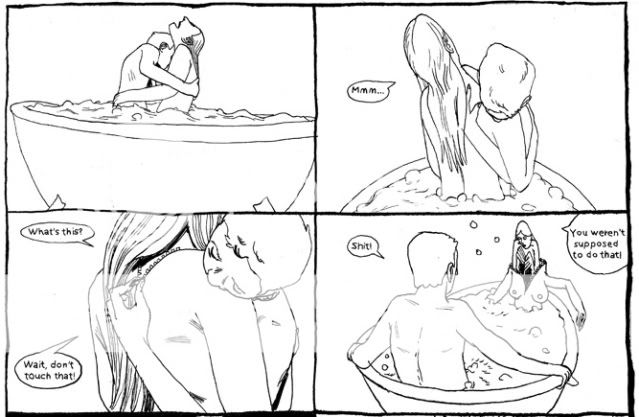
* Dig Lamar Abrams’ strangely erotic drawings of Joyce DeWitt and a woman in a striped dress farting!


* Tom Spurgeon is collecting nominees for the decade’s best superhero comics, and here’s what people are suggesting.
Comics Time: Remake
November 23, 2009
Remake
Lamar Abrams, writer/artist
AdHouse, May 2009
144 pages
$12.95
Buy it from AdHouse for the low low price of $5.95
Look at that cover! Oh man, striking, isn’t it? As a package–with its bold cover image and tight title font and friendly digest size and Powr Mastrs-style bendy cover and Helvetica-heavy title pages–Remake is somethin’ special. As a comic? Mmmm, I’m not quite there with it. What you’ve got here is a gentle superhero parody in the vein of Jeffrey Brown’s Bighead books–or maybe Bighead crossed with Be a Man, since author Lamar Abrams’s target here seems to be the superhero’s propensity for narcissism, destructiveness, and pique. His “hero,” the diminutive boy-robot Max Guy (he’s not named Remake, much to my surprise; hey, why is this book called Remake anyway?) is a blustery, shallow, self-absorbed asshole. He’s prone to sulking, bragging, talking shit, salting game, pigging out, playing video games, befriending his enemies and alienating his allies, breaking the fourth wall, vomiting, and so on. It sounds fun, if that’s the sort of thing you go for. And Abrams’s art helps, though I prefer the uniform line weight, rigid grid, and simplistic designs of the earlier comics collected here to the looser, more Scott Pilgrim-y work toward the back of the book; the earlier material feels like an experiment in staging dramatic, dynamic action and poses while deliberately underselling them with the tools at your disposal, like an 8-bit cover of “Bohemian Rhapsody.” But here’s the thing: It sounds like more fun than it is. Maybe I just got off on the wrong foot with the book, since its first three strips center on homophobia and animal cruelty gags (I know it’s the character, not the author, but still), but I just didn’t laugh a lot at this. There was a funny bit toward the end where Max Guy comes rocketing down from the stratosphere in the middle of a fight to smack his opponent with a pie to the face, and when he’s asked where the pie came from he said that he bought it from a guy selling them on a cloud, and then there’s a jump cut to a little guy with a mustache on a cloud with a stack of pies who says “I’m practically giving them away!”–that made me laugh. The rest, a borderline meh. It’s energetic cartooning, no doubt, and generally importing video-game influences to create something more free-form than conventional action-adventure comics plotting would allow is a good look, but for me it just didn’t cohere into a whole as winning as some of its parts.
You’re gonna wake up one morning and KNOW which side of the franchise you’ve been shipping on!
November 23, 2009New Moon isn’t really a better movie than Twilight, but it’s a lot more fun. I’ll grant you that seeing it on opening night contributed a great deal to that impression, I’m sure. Now, I’m a neutral party in the big Team Edward/Team Jacob dust-up; I wore a Twin Peaks t-shirt to the screening, so I guess I’m on Team Bob. Still, many of my favorite moments of the evening didn’t take place on screen. There was the shaggy-haired kid with the Judas Priest t-shirt we sat next to, clearly dragged along by his female friends–when we asked if he minded us sitting between him and them, he said “Oh, it doesn’t matter, I’ll probably be asleep through the whole thing anyway”; later he responded to a parodic film-within-the-film action flick by shouting “I wanna be watching that movie!” There was the high-pitched squealing any time a male teenage character (or Ashley Greene’s Alice, for some reason…?) came on screen, doubled in decibels anytime one of them took his shirt off. In that respect it was really 17-year-old Taylor Lautner’s show–when his buff, bare-chested teen-wolf character Jacob spent a scene glowering topless in the rain, there wasn’t a dry seat in the house. And there was the Twi-mom we overheard in the parking lot loudly proclaiming of Lautner (to the chagrin of her daughter), “Six-pack? More like an eight-pack! Believe me–I was counting!”
But even if our screening’s highlights came from the audience and not the film itself, that’s not to say that the film wasn’t a hoot at times too. Sure, I may have gotten more out of scarfing down pretzel bites and nacho cheese and giggling at every collective screech and sigh from our tweenage theater-mates. But don’t let’s forget that before he presided over the stillbirth of the would-be His Dark Materials franchise with The Golden Compass and subsequently shattered box-office records and Batman-fan hearts with New Moon‘s performance this past weekend, Chris Weitz helped helm American Pie. I for one thought he brought that same eye for the absurdity of teenage emotions’ intensity to this material. Ridiculous tableaux abounded here, from the perpetually shirtless posse of Native American were-twinks to a ride in an elevator with our heroes and a trio of vampire-royalty enforcers that nearly brought down the house. And as in the first film, the four human friends of Kristen Stewart’s lead moper Bella were clearly the movie’s most valuable players, from Anna Kendrick’s motormouth remonstrations as Jessica to Michael Welch’s superbly played hormonal awkwardness as Mike.
Best of all, though, were the Volturi, the Italy-based ruling council for the vampires of the Twilight world. Their apparent top dog, Aro, was played by Michael Sheen with all the gleeful giggling gusto of someone who thought it might be fun to pretend he was in a better vampire movie. He’s a grinning, fey freak straight out of the Emperor Paplatine playbook, an undead dandy, and I enjoyed every second he was on screen. Equally impressive in smaller roles–due in large part to their striking appearances–were Daniel Cudmore as Felix, a towering vampire guard who smashes Robert Pattinson’s emo vampire Edward through a roomful of marble furnishings in Zack Snyder slow/fast-motion style; and Dakota Fanning as Jane, a sadistic vampire teen telekinetic upon whom I’d have developed a crippling crush as a kid. The group is responsible for the film’s one true moment of horror, too, albeit offscreen: As Bella, Edward, and Alice are led from their forced audience with Volturi, a tourist group–complete with prominently shot children!–is led in, and their screams as they figure out what’s going on actually are tough to hear.
The Volturi certainly compare favorably to the misbegotten trio of vampiric antagonists whose boilerplate antics gave the first film its nominal climax, a role augmented since author Stephenie Meyer apparently never really bothered to put one in the book, from what I’m told. Edi Gathegi’s dreadlocked and accented Laurent returns here, pulling an unexplained 180 from his face turn in the first film–something Bella actually remarks upon as he prepares to kill her, but with no explanation forthcoming. He gets eaten by werewolves, which is pretty funny. Faring somewhat better is Rachelle Lefevre’s extravagantly red-headed Victoria, out for vengeance for the slaying of her grungy mate James (Cam Gigandet) by Edward and his family in the first movie. I don’t think she says a single word in this movie–and behind-the-scenes shenanigans have led her to be replaced by Bryce Dallas Howard in subsequent sequels, so oh well–but she makes a hell of an impression in two of the film’s most visually impressive sequences. First, she has a long chase sequence with the wolfpack, choreographed Matrix-style and soundtracked beautifully by Thom Yorke (!). Second, even though this breaks even more vampire rules than the astonishingly dopey “sparkle in the sunlight” thing, she ends up in the ocean at one point, and the two brief shots we get of her in there point to a visually rich vein of “water vampire” fiction should anyone else feel comfortable throwing tradition to the wind.
All that being said, New Moon is still, in many respects, a train wreck. For one thing it’s riddled with plot holes big enough to drive Bella’s truck through. If Edward can read minds, why on earth would he think Alice was “lying” if she tried to stop him from killing himself out of the belief that Bella is dead? Wouldn’t he know, for certain, that she wasn’t? Why did the vampire who helped them in movie one turn evil in movie two? Why is it a big deal Bella can resist Edward and the Volturi’s powers, when she’s perfectly susceptible to Alice and Jasper’s? Why would “exposing himself” make people think Edward was anything but a pale human covered in body glitter? Where do the werwolves stash all those extra shorts?
But as I always say, you can put up with a lot of plot inconsistency if the rest of what you’re getting is entertaining enough. And in New Moon‘s case, there are still way, way too many stilted conversations between Bella and Edward, Bella and Jacob, and even Bella and her cop dad (the character who elicited the loudest squeals from the Missus, fwiw–I believe the phrase “You have the right to remain sexy” was used) that consist almost soley of variations on “no, don’t, can’t, won’t.” For these conversations, the emotional dial seems permanently lodged at “pained intensity.” I wish Weitz, and returning screenwriter Melissa Rosenberg, had taken the time to transmute Meyer’s leaden prose into something approaching genuine teenage interaction, even between teenagers who are painfully in love. It definitely gives Pattinson and Stewart little to work with. They’re both beautiful, but while I’ve heard knowledgeable people make the case that they’re great young actors, you’ll find precious little evidence of it here, unless you’re looking for the most realistically awkward, stilted, and painful pause-laden teenage dialogue since Sofia Coppola in The Godfather Part III. (Seriously, at one point in the middle of one of Pattionson’s lines, he stretched a pause out so long that I was this close to yelling “Say it!” at the screen, Rocky Horror-style.)
Meanwhile, structural problems bedevil the film just as they did its predecessor. There’s not really a climax, since once again the key problem isn’t introduced until about twenty minutes prior to its resolution. And there’s little flow–things are fine, then Edward leaves because of supposedly unavoidable problems that if you’re paying attention were mostly his own fault, then Bella mopes, then she befriends Jacob, then Jacob mopes, then there’s some cliffdiving, then Alice comes back, then Jacob mishandles a phone call, then there’s all the Volturi business, then it’s over. Somewhere, Robert McKee is rolling in his screenwriting seminar.
I’ve written that Twilight looked like the product of people who weren’t convinced they’d pull it off. New Moon, by contrast, looks (and sounds) like a sure thing. It’s much slicker, for one thing–gone is Twilight director Catherine Hardwicke’s jittery rhythm, none-more-blue color palette, and general earthiness, all of which have been known to irk viewers but seem positively art-house compared to New Moon‘s sterile spectacle. Gone too is the great Carter Burwell’s score and its memorable piano-tinkle theme, replaced by run-of-the-mill Danny Elfmanisms from Alexandre Desplat. The soundtrack, by contrast, traded up from Hot Topic to Pitchfork with an array of critic’s-darling indie-rockers–the lead single from Twilight was by Paramore; the lead single here is from Death Cab for Cutie. It helps, believe me, particularly in that awesome Thom Yorke sequence, but its relative gutsiness made me wish the rest of the film had been as willing to take chances.
(Now, what you won’t hear me do in this case is kvetch about Bella’s lack of agency. Regardless of what happens in the other volumes, and regardless of Meyer’s Mormonism and the genuine creepiness of the whole “make me a vampire so I can be Edward’s sister-wife in your weird vampire incest family,” I took Bella’s actions and inactions here as simply the behavior of an emotionally devastated teenager. It’s unfair to dump all the heroines you loved as a teenage girl on her back–just let her mourn getting dumped and use her obviously smitten platonic friend to get over it, as countless teenagers have done.)
So no, it’s not “a good movie.” But I had a great time at the movies watching it. You know? I left feeling like I’d just seen the female-tween equivalent of Road House: pure pandering to its audience’s id, starring a dude who can’t keep his shirt on. You holler at the screen during the fanservice, you cheer during the fight scenes, you cringe during the love scenes, you get to watch a bitchin’ vampire-vs.-werewolf-vs.-Radiohead scene, there’s some cool evil supervampires who act like Lokar from Space Ghost Coast to Coast, the guy who played Colossus reenacts 300 all over Robert Pattinson’s gorgeous flat face, there’s cliffdiving and indie rock and shirtless wolfpacks …Grab your popcorn, count your eight-packs, and enjoy the cultural phenomenon.
